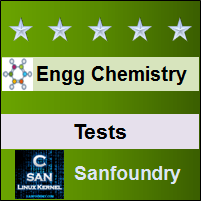 Our Engineering Chemistry II Tests allow you to experience an online examination in the real-time environment. In every online test on Engineering Chemistry II, you will be presented with Multiple Choice Questions (MCQs) which will test your skills in Engineering Chemistry II Concepts in a detailed and comprehensive manner. In the test, each question will have 4 options to choose from. You should select only 1 correct option as an answer and then move on to the next question. Once you submit answers to all the questions, you will be given your final test score.
Our Engineering Chemistry II Tests allow you to experience an online examination in the real-time environment. In every online test on Engineering Chemistry II, you will be presented with Multiple Choice Questions (MCQs) which will test your skills in Engineering Chemistry II Concepts in a detailed and comprehensive manner. In the test, each question will have 4 options to choose from. You should select only 1 correct option as an answer and then move on to the next question. Once you submit answers to all the questions, you will be given your final test score.In the Online Engineering Chemistry II Test, for every correct answer, you will be given 2 points. There will also be negative marking of -1 for every wrong answer. So, you will have to be more careful in choosing the answers to the question in your online examination. If needed, you should skip to the next question and come back to the previous question later so that you can do proper time management for the online mock tests.
Based on your score, you would be given one of the following Grades:
Grade A* - Genius (You scored 100%)
Grade A - Excellent (Your score is in the range of 80% to 99%)
Grade B - Good (Your score is in the range of 60% to 80%)
Grade C - Average (Your score is in the range of 40% to 60%)
Grade D - Poor (Your score is in the range of 0% to 40%)
There will be 5 types of Engineering Chemistry II Tests. The details of each of these tests are as follows:
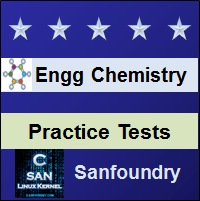 1. "Engineering Chemistry II Practice Tests 1-10" - In Engineering Chemistry II practice tests, there will be a series of practice tests wherein you can test your Engineering Chemistry II concepts on every chapter separately. There are totally 10 different chapters on this subject and hence there will be 10 different practice tests wherein each practice tests covers one chapter exclusively. There will not be any time limit on these tests. So, Engineering Chemistry II Practice Tests should be the first set of tests which you should attempt. Goto these practice tests here.
1. "Engineering Chemistry II Practice Tests 1-10" - In Engineering Chemistry II practice tests, there will be a series of practice tests wherein you can test your Engineering Chemistry II concepts on every chapter separately. There are totally 10 different chapters on this subject and hence there will be 10 different practice tests wherein each practice tests covers one chapter exclusively. There will not be any time limit on these tests. So, Engineering Chemistry II Practice Tests should be the first set of tests which you should attempt. Goto these practice tests here.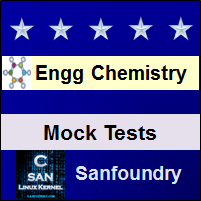 2. "Engineering Chemistry II Mock Tests 1-10" - In Engineering Chemistry II mock tests, there will be a series of mock tests wherein you can test your Engineering Chemistry II concepts on every chapter separately, but there will be a fixed time limit per mock test. Here also, there are 10 mock tests wherein each mock test covers only one chapter exclusively. So, it is similar to Engineering Chemistry II Practice Tests, but with an added constraint of time limits. You should try Engineering Chemistry II Mock Tests if you are appearing for any online examination soon. Goto these mock tests here.
2. "Engineering Chemistry II Mock Tests 1-10" - In Engineering Chemistry II mock tests, there will be a series of mock tests wherein you can test your Engineering Chemistry II concepts on every chapter separately, but there will be a fixed time limit per mock test. Here also, there are 10 mock tests wherein each mock test covers only one chapter exclusively. So, it is similar to Engineering Chemistry II Practice Tests, but with an added constraint of time limits. You should try Engineering Chemistry II Mock Tests if you are appearing for any online examination soon. Goto these mock tests here.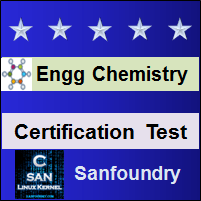 3. "Engineering Chemistry II Certification Test" - Once you are thorough with your Engineering Chemistry II concepts, then you can try our Engineering Chemistry II Certification Test wherein your name will be mentioned in Top Rankers list, if you scored either Grade A* or Grade A in the Engineering Chemistry II Certification Test. The Certification Test is free. Goto Engineering Chemistry II Certification test here.
3. "Engineering Chemistry II Certification Test" - Once you are thorough with your Engineering Chemistry II concepts, then you can try our Engineering Chemistry II Certification Test wherein your name will be mentioned in Top Rankers list, if you scored either Grade A* or Grade A in the Engineering Chemistry II Certification Test. The Certification Test is free. Goto Engineering Chemistry II Certification test here.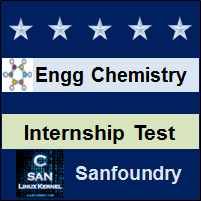 4. "Engineering Chemistry II Internship Test" - If you are interested to do Internships in Engineering Chemistry II at Sanfoundry, then you must take our Engineering Chemistry II Internship Test. If you scored either Grade A* or Grade A in Engineering Chemistry II Internship Test, then you are eligible for Internship at Sanfoundry in Engineering Chemistry II. Goto Engineering Chemistry II Internship test here.
4. "Engineering Chemistry II Internship Test" - If you are interested to do Internships in Engineering Chemistry II at Sanfoundry, then you must take our Engineering Chemistry II Internship Test. If you scored either Grade A* or Grade A in Engineering Chemistry II Internship Test, then you are eligible for Internship at Sanfoundry in Engineering Chemistry II. Goto Engineering Chemistry II Internship test here.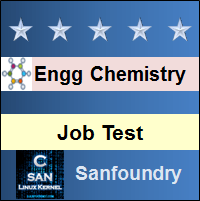 5. "Engineering Chemistry II Job Test" - If you are a fresher, a dropout, an experienced person and if you know Engineering Chemistry II well and looking out for jobs in Engineering Chemistry II domain at Sanfoundry (or our Network of Companies), then you should try and qualify our "Engineering Chemistry II Job Test". If you scored either Grade A* or Grade A in Engineering Chemistry II Job Test, then you are eligible for a Job at Sanfoundry (or our Network) in Engineering Chemistry II domain. Kindly note that you can repeat this job test after a gap of 30 days from the day of last attempt of the test. Goto Engineering Chemistry II Job test here.
5. "Engineering Chemistry II Job Test" - If you are a fresher, a dropout, an experienced person and if you know Engineering Chemistry II well and looking out for jobs in Engineering Chemistry II domain at Sanfoundry (or our Network of Companies), then you should try and qualify our "Engineering Chemistry II Job Test". If you scored either Grade A* or Grade A in Engineering Chemistry II Job Test, then you are eligible for a Job at Sanfoundry (or our Network) in Engineering Chemistry II domain. Kindly note that you can repeat this job test after a gap of 30 days from the day of last attempt of the test. Goto Engineering Chemistry II Job test here.For every "Engineering Chemistry II Practice Test", Total Questions: 20, Total Time: Unlimited.
For every "Engineering Chemistry II Mock Test", Total Questions: 20, Total Time: 20 Minutes.
For "Engineering Chemistry II Certification Test", Total Questions: 50, Total Time: 1 hour.
For "Engineering Chemistry II Internship Test", Total Questions: 50, Total Time: 1 hour.
For "Engineering Chemistry II Job Test", Total Questions: 50, Total Time: 1 hour.
Before you get started on these series of online tests on Engineering Chemistry II, you should learn, study and practice our collection of 1000 MCQs (Multiple Choice Questions and Answers) on Engineering Chemistry II here. We also prefer that you should practice Engineering Chemistry II practice tests and mock tests completely before attempting the certification test.
Here is the list of online practice tests and mock tests on Engineering Chemistry II. Each online test focuses on a "Specific chapter of Engineering Chemistry II". So, you should try both practice test and mock test on every chapter to do a self-assessment of your knowledge (along with time-limit constraints) in every area or sub-topic of Engineering Chemistry II. Engineering Chemistry II Certification test, Internship test, and Job Test are mentioned at the end of this list.
1. Engineering Chemistry II Test 1 – This set of online test on “Engineering Chemistry II” tests your skills on Classification of Fuel, Characteristics of Fuel, Calorific Value – 1, Calorific Value – 2, Determination of Calorific Value of Solid and Non-Volatile Liquid Fuels – 1, Determination of Calorific Value of Solid and Non-Volatile Liquid Fuels – 2, Determination of Calorific Value of Gaseous and Volatile Liquid Fuels.
2. Engineering Chemistry II Test 2 – This set of online test on “Engineering Chemistry II” tests your skills on Solid Fuels – 1, Solid Fuels – 2, Coal – 1, Coal – 2, Characteristics of Coal, Analysis of Coal.
3. Engineering Chemistry II Test 3 – This set of online test on “Engineering Chemistry II” tests your skills on Coal Technology, Pulverised Coal, Carbonization of Coal, Secondary Solid Fuels – 1, Secondary Solid Fuels – 2, Liquid Fuels, Petroleum – 1.
4. Engineering Chemistry II Test 4 – This set of online test on “Engineering Chemistry II” tests your skills on Petroleum – 2, Liquified Petroleum Gas (LPG), Cracking – 1, Cracking – 2, Synthetic Gasoline from Non-Petroleum Sources – 1.
5. Engineering Chemistry II Test 5 – This set of online test on “Engineering Chemistry II” tests your skills on Synthetic Gasoline from Non-Petroleum Sources – 2, Knocking, Anti Knocking Agents – 1, Anti Knocking Agents – 2, Octane and Cetane Number, Gaseous Fuels – 1, Gaseous Fuels – 2.
6. Engineering Chemistry II Test 6 – This set of online test on “Engineering Chemistry II” tests your skills on Petrochemicals, Numerical Problems Based on Combustion and Fuel Gas Analysis, Efficiency of Combustion, Combustion Calculation, Alkalinity of Water and its Estimation, Hardness of Water, Boiler Feed Water.
7. Engineering Chemistry II Test 7 – This set of online test on “Engineering Chemistry II” tests your skills on Lime Soda Process, Zeolites, Calgon Conditioning, Desalination of Brackish Water, Reverse Osmosis, Causes and Effects of Corrosion.
8. Engineering Chemistry II Test 8 – This set of online test on “Engineering Chemistry II” tests your skills on Wet Theory of Corrosion, Factors Influencing Corrosion, Protective Measures Against Corrosion, Faraday's Laws of Electrolysis, Fuel Cells, Galvanic Series.
9. Engineering Chemistry II Test 9 – This set of online test on “Engineering Chemistry II” tests your skills on Applications of Electroplating, Electroplating Equipment and Operating Conditions, Electroplating Baths – 1, Electroplating Baths – 2, Characteristics of Electroplating Wastes, Oils and Fats – 1, Oils and Fats – 2.
10. Engineering Chemistry II Test 10 – This set of online test on “Engineering Chemistry II” tests your skills on Lubricants, Soaps, Detergents, Catalysts, Catalysis Reactions, Colloids – 1, Colloids – 2, Application of Colloids.
Sanfoundry will issue a Certificate of Merit to Top 5 Rankers for a given month provided that they have scored either A* or A Grade in the Contest. If you are interested, then kindly register below. After registration, you can take the test anytime (24x7).
